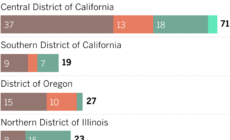-
This May Be Our Last Chance to Get It Right in Venezuela - 47 mins ago
-
Girl 6, Tells Parents She Hates Her Name—So They Take Drastic Action - about 1 hour ago
-
Myanmar’s Health Crisis Spills Over Borders - 2 hours ago
-
Death Toll in UPS Plane Crash Rises to 15 - 2 hours ago
-
JJ Redick Rips Into Lakers After Blowout Loss vs Rockets - 2 hours ago
-
2 killed, 3 injured in Christmas crash on I-5 near Pyramid Lake - 2 hours ago
-
Trump Has a New Auto Loan Tax Break. Here’s Who Could Benefit. - 3 hours ago
-
Lakers Make Critical Decision on Austin Reaves vs. Rockets - 4 hours ago
-
Trump Administration Emphasizes Religion in Official Christmas Messages - 4 hours ago
-
What to Know About U.S. Military Action in Nigeria - 4 hours ago
Satellite Map Shows Scorching Heat Over Western US
A new satellite map released by NASA shows a dramatic view of the summer heat that has been scorching parts of the United States and Canada.
Much of the western part of North America was hit by a “unseasonably high temperatures” at the start of September, with record heat reported in the Canadian province of British Columbia and the Pacific Northwest region of the U.S. after a high-pressure zone known as an “omega block” settled over the region for several days.
The latest satellite map captures air temperatures in North America on September 3 at 2 p.m. Pacific Time, modeled at 6.5 feet above the ground.
It was produced using observations taken by NASA’s GOES weather satellite. The darkest reds of the map highlight areas where temperatures approached 104 degrees Fahrenheit, NASA noted.

NASA Earth Observatory
“Omega blocks get their name because the upper air pattern looks like the Greek letter omega Ω,” notes the National Oceanic and Atmospheric Administration (NOAA).
An omega block is a blocking pattern that can “set up and be stubborn to move,” notes the National Weather Service (NWS), adding: “Sometimes they bring us great weather, sometimes not.”
Blocking patterns occur when high-pressure and/or low-pressure centers settle over a region in such a way that they prevent other weather systems from moving through.
“When the blocking pattern is in place, other systems are forced to go around it,” NOAA explains, noting that blocking patterns can remain in place for several days, leading to “long spans of persistent weather for locations under the block.”
Due to their size, “omega blocks are often quite persistent and can lead to flooding and drought conditions,” depending on the location under the pattern. “Cooler temperatures and precipitation accompany the lows, while warm and clear conditions prevail under the high,” NOAA says.
On September 3, Canada saw a new record high temperature for September—105.4 degrees Fahrenheit—set in Ashcroft, British Columbia, around 120 miles northeast of Vancouver. That level of heat would be more common in parts of the U.S. southwest region, in places like Phoenix, Arizona, at this time year, NASA notes.
Temperatures also surged east of the Cascade Range in Washington state, where Spokane tied its daily record of 98 degrees Fahrenheit on September 3. The previous two days saw temperatures reach 99 degrees Fahrenheit—the highest in September for that location in a record that goes back to 1881.
The record September heat follows a drier-than-normal summer in the region.
Back in July, most of Canada saw “below- to well below-average precipitation,” intensifying drought across the country, according to the Canadian government.
“In British Columbia, persistent rainfall deficits and dwindling stream flows exacerbated dry conditions. The northern and central Prairies saw exceptionally low precipitation, rapidly deepening drought in those regions.
“Meanwhile, southern and eastern Ontario received hot, dry conditions that expanded existing dry and drought areas. Atlantic Canada’s July rainfall deficits resulted in the expansion and increased severity of drought.”
The dry conditions have contributed to several large fires “burning out of control” in British Columbia, when it’s more typical for seasonal rains at this time of year, NASA explained.
Do you have a tip on a science story that Newsweek should be covering? Do you have a question about weather? Let us know via science@newsweek.com.
Source link















